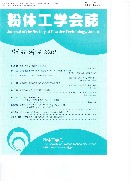
- |<
- <
- 1
- >
- >|
-
Hideo Kawahara, Tadashi Hirozane, Koichiro Ogata2010Volume 47Issue 4 Pages 206-213
Published: April 10, 2010
Released on J-STAGE: April 19, 2010
JOURNAL FREE ACCESSWe have proposed a new hopper of dual structure which is composed of the cone hard container and the flexible container of soft material. This hopper can avoid the blockage phenomenon of cohesive powder near the orifice using the expansion of flexible container by the vibration of periodic air pressure which changes on the opening and shutting of the solenoid-controlled valve. In this study, we experimentally investigated the effectiveness of this hopper for the discharge of cohesive powder. Also, the effect of the supplied air pressure, the valve timing and the particle properties for the discharge characteristics of this hopper is examined where the flyash of 22.4 μm and the silica sand of 15.6 μm were used for this experiment. It can be confirmed that the dual structure hopper using the air vibration is effective for the discharge of the cohesive powder. Further, it is found that the air pressure and the open time of valve greatly influence the discharge characteristic of the powder.View full abstractDownload PDF (1139K) -
Yoshinori Yamada, Mikio Sakai, Yusuke Shigeto, Masao Tsuchiya, Shuichi ...2010Volume 47Issue 4 Pages 214-221
Published: April 10, 2010
Released on J-STAGE: April 19, 2010
JOURNAL FREE ACCESSThe Discrete Element Method (DEM) is widely used in computational granular dynamics. The DEM is a Lagrangian approach where individual particles are calculated based on the Newton's second law of motion. Hence, the DEM enables us to investigate the granular flow characteristics at the particle level. Spherical particles has been used in most of the DEM simulations because the contact judgement is easy. On the other hand, the particle shape might affect the powder flowability. When effect of the particle shape on the flowability cannot be neglected, the particle shape was modeled by meshes or cluster of calculated particles in the past studies. However, the calculation cost of these models became too expensive. As a result, these models could not be applied in large scale powder systems. Thereat, a new modeling which gives the effect of particle shape is developed in the present study. This model is called rotational resistance model. The rotational resistance based on the particle shape is modeled in the DEM. This model can simulate the nonspherical particle behavior without excessive calculation cost. The adequacy of this model is proved by experiment in this study.View full abstractDownload PDF (993K) -
Yasuhiro Hirai, Kenji Kofu, Mitsuaki Ochi, Hikaru Miura2010Volume 47Issue 4 Pages 222-229
Published: April 10, 2010
Released on J-STAGE: April 19, 2010
JOURNAL FREE ACCESSThe relationship between the reduction of friction coefficient by the acoustic pressure and deflection vibration, and the particle density has been shown when ultrasonic was applied for two parallel plates and 7 kinds of particles. Additionally, the maximum of particle density which could receive the friction reduction effect by the acoustic pressure has been expressed. In this study, in order to evaluate the effect by them, the distribution of acoustic pressure between reflection plate and the vibration plate by the acoustic pressure have been measured. As a result, it was clear that acoustic pressure distribution became the almost same whether ultrasonic was applied for the either plate, and the reflection plate vibrate little. Therefore it was possible to divide the influence of acoustic pressure and deflection vibration on the friction reduction.View full abstractDownload PDF (992K)
-
Yasuhisa Adachi, Motoyoshi Kobayashi, Tomonori Fukasawa, Peter J. S ...2010Volume 47Issue 4 Pages 230-239
Published: April 10, 2010
Released on J-STAGE: June 17, 2017
JOURNAL RESTRICTED ACCESSThe viscosity and yield stress of flocculated suspensions were reviewed in terms of fractal structure and strength of flocs. The fractal structure is formed by the sequential collision process of clusters. However, the cluster rearrangement process is important with the number of contacts between clusters. Floc strength is determined by the product of cohesive force per contact and the number of contacts between clusters. This simple expression will determine the size of flocs at given shear rate, thus determining effective volume of flocs. Shear thinning behavior is expressed by putting this value into Mori-Ototake viscosity equation. The asymptotic behavior of shear stress at zero shear limit is interpreted as yield stress. The obtained yield stress is expressed as a function of volume fraction of colloid. The functional form is different from that obtained for the flocculated sediment with vane in rather concentrated region. Importance for further analyses on the loose, soft and unstable sediment with large deformable flocs is implied.
View full abstractDownload PDF (1074K)
-
Jun Oshitani2010Volume 47Issue 4 Pages 240-246
Published: April 10, 2010
Released on J-STAGE: June 17, 2017
JOURNAL RESTRICTED ACCESSAn emulsion is a mixture of two immiscible liquids such as oil and water, in which one is dispersed in the other as droplets. Generally, surfactants are used to form a stable emulsion. Surfactants, having both hydrophobic carbon chains and hydrophilic polar headgroups, position themselves on the interface between oil and water to stabilize an emulsion. Do you kwon that counterions, a part of surfactants, play an important role in stabilizing an emulsion? The counterions affect the properties of emulsion, such as the phase behavior and the shape. "Screening effect" is one of the important roles of counterions; electrostatic repulsions between polar headgroups must be screened to a certain extent by the counterions in order to form a stable emulsion. Here, these counterions' roles are reviewed by taking surfactant AOT-based W/O (water in oil) emulsions for instance.
View full abstractDownload PDF (772K)
- |<
- <
- 1
- >
- >|